
|

| Shield machines with full-face excavation (SM-V) differ from those with partial excavation (SM-T) in that they process and loosen the whole working face in one working step by means of a rotating boring head equipped with corresponding excavation tools. | | (Image: Shield machines with full-face excavation - Working face with natural support SM-V1) | (Image: Shield machines with full-face excavation - Working face with mechanical support SM-V2) | | (Image: … |
|
|

|

|

|

|
(Image: Attention!)
Excavation machines are used with shield machines with partial excavation. Operating and steering of the shield machine are carried out directly at the site by a machine operator who has a continuous view of the working face. |
|
(Image: Shield machine with fixed installed boom cutting machine - With axial cutting head) |
(Image: Axial cutter head of the boom cutting machine equipped with round shank cutter bits) |
(Image: Principles … |
|

|

Depending on the in-situ subsoil, the following excavation machines are usually utilized in these shield machines: -
Excavator with exchangeable excavation arrangements (shovel bucket, backhoe, ripping tooth or ripper, hydraulic hammer)
-
Boom cutting machine with axial or transverse cutter head.
(Image: Shield machines with mechanical partial excavation - working face with natural support with reference to [FI-Herreb] [Image: S&P GmbH]) (Image: Shield … |
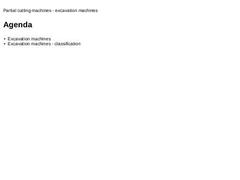
|

|

|

|
(Image: Attention!)
Cutter heads are used with shield machines with full-face excavation.
A difference is made between: -
Cutting wheel (soft soil)
-
Scraper cutter head
-
Rock cutter head
|
|
|
|
(Image: Three-spoke rim cutting wheel with scraper teeth (standard bore head) [FI-Rasa]) |
(Image: Scraper cutter head with pick bits and scraper teeth (standard bore head) [FI-Rasa]) |
(Image: Rock cutting head with disc cutters and TCI insert roller cutter … |
|

|

|
(Image: Three-spoke rim cutting wheel with scraper teeth (standard bore head) [FI-Rasa]) The cutting wheel is a largely openly designed drilling head that is not used for the mechanical support of the working face. Their advantages lie with the low coverage and thus the good accessibility of the working face when needed. A distinction is made between the spoke and the rim cutting wheel [Maidl98]. |
|
(Image: Possible designs of boring heads for earth … |
|

|

|
(Image: Scraper cutter head with pick bits and scraper teeth (standard bore head) [FI-Rasa])
Scraper cutter heads are nearby, closed, disc-shaped boring heads or cutting wheels with adjustable or fixed supporting plates with soil entry openings that are adapted to suit the size of the maximum particle to be transported. |
|
(Image: Open shield machine with scraper cutting head and mechanical support of the working face - Variably adjustable soil entry … |
|

|

|
(Image: Rock cutting head with disc cutters and TCI insert roller cutter for hard rock [FI-Rasa])
Rock cutter heads consist of almost closed, disc-shaped basic constructions with usual slot-shaped entry openings (removal slots) and are flat with a rounded periphery, slightly coned or almost convex. |
|
(Image: Rock cutter head of a shield with fluid support of the type AVN 1500 for jacking in rock - view) |
|
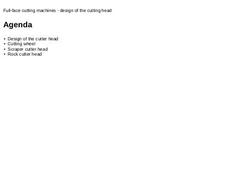
|

|

|

(Image: Attention!) In order to excavate the soil or rock at the working face, the cutter head must be equipped with excavation tools adapted to the geotechnical conditions. The following excavation tools are available: -
Rippers (soft ground)
-
Scraper teeth (soft ground)
-
Round shank cutter bits
-
Roller cutters (disk cutters)
-
Centre cutters (soft ground)
(Image: Excavation tools [Source: STEIN Ingenieure GmbH]) (Image: Massive wear on a cutting wheel … |

|

Rippers are blunt tools inserted at right angles to the working face and usually have a square shape. Their purpose is the loosening of non-cohesive soils such as gravel, sand and silt, including the numerous intermediate variants, from their natural positions. Cohesive soils are kneaded if pick bits are used [Maidl94]. Rippers are commonly used as primary excavation tools only or together with disc cutters. (Image: Variants of rippers ) |

|

Softground tools as buckets and cutting knifes are used in many forms also with replaceable hard metal cutting edges. Buckets and cutting knifes are used mostly for cutting-scraping excavation in cohesive loose sediments such as clay, loam, soft slate, clayey silt, etc. but can also be used in non-cohesive soils [Maidl94]. Buckets: Transportation of excavated material to the excavation chamber or into the reamer channels. They are built in lip segments … |
|

|

Round shank cutter bits are manufactured in different designs and geometries to suit the ease of breakout ability of the rock. They are used for destructive excavation mostly in rock that is easily to difficultly excavated. (Image: Wear when using a shield machine with fixed installed boom cutting machine with an axial cutting head while jacking pipes DN/ID 1600 in rock with uniaxial compressive strengths up to 200 N/mm2 ("greywacke") and a jacking … |

|

Roller cutters are designed as disk cutters, cutters with inserted teeth or TCI disk cutters and are axially rotatable. They destroy rock and stones or blocks embedded in loose rock. (Image: Types of roller cutters [FI-Palmie] - (Tungsten carbide) Insert roller cutter) (Image: Types of roller cutters - Triple disc cutters) (Image: Types of roller cutters - Triple disc cutters) (Image: Types of roller cutters - Triple disc cutters) (Image: Installed … |

|

|
(Image: Attention!)
With increasing stability and/or hardness of the rock and rolling speed of the disc cutters the temperature and wear of the single discs increases [Schad03]. |
|
(Image: Forces affecting the disc cutters ? single disc cutter with reference to [Schad03] [Image: S&P GmbH]) |
(Image: Forces affecting the disc cutters ? single disc cutter with reference to [Schad03] [Image: S&P GmbH]) |
Forces affecting the disc cutters - single disc … |
|

|

Centre cutters are excavation tools arranged in advance in the centre of the boring head in order to release the pressure in the centre of the working face during boring and especially in cohesive soils such as clay and silt with low to high plastic properties to counteract sticking of the boring head. |

|

|
(Table: Combination possibilities of the various excavation tools as well as the utilization of stone crushers with reference to the subsoil conditions) |
|

|

Backloading:
In shield machines with full face excavation, special attention must be paid to the possibility of changing the excavation tools without changing the support conditions of the working face. One method to securely and easily perform the task underground without withdrawing the machine from the back of the drill head is the so-called backloading system. Advantages of the backloading system: |
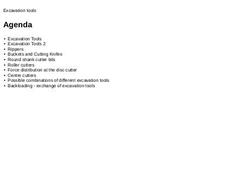
|

|
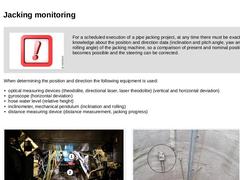
|

|
(Image: Attention!)
For a scheduled execution of a pipe jacking project, at any time there must be exact knowledge about the position and direction data (inclination and pitch angle, yaw angle, rolling angle) of the jacking machine, so a comparison of present and nominal position becomes possible and the steering can be corrected. |
|
When determining the position and direction the following equipment is used: -
optical measuring devices (theodolite, …
|
|

|

|
(Image: Technical components in pipe jacking - control and steering unit) (Image: Control and steering unit) |
Main operator's stand:
Operator's stand, from where the boring process and the forward movement of the shield machine are controlled [DINEN12336:2010]. |
|
Operator's stand:
Any place of a shield machine or the trailing shield segment, from where one or several functions of the shield machine, the trailing shield machine or their independent … |
|
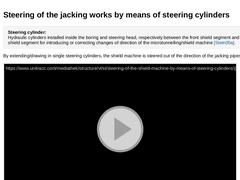
|

Steering cylinder:
Hydraulic cylinders installed inside the boring and steering head, respectively between the front shield segment and the trailing shield segment for introducing or correcting changes of direction of the microtunnelling/shield machine (not found). By extending/drawing in single steering cylinders, the shield machine is steered out of the direction of the jacking pipes. (Video: Steering of the shield machine by means of steering cylinders) |
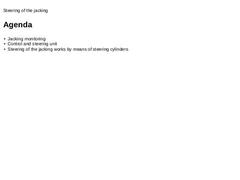
|

|
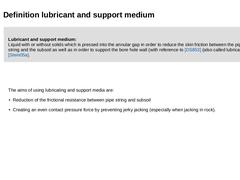
|

Lubricant and support medium:
Liquid with or without solids which is pressed into the annular gap in order to reduce the skin friction between the pipe string and the subsoil as well as in order to support the bore hole wall (with reference to [DS853] (also called lubricant) [Stein05a]. |
The aims of using lubricating and support media are: |
|